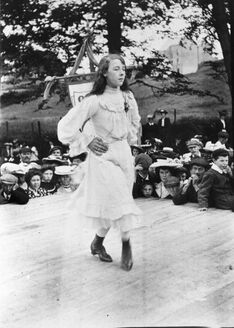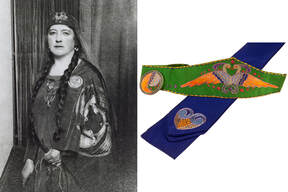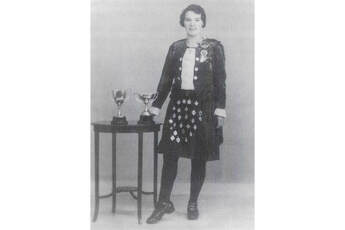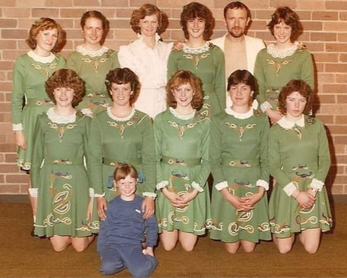 An Irish dancer performing in 1904 in her “Sunday Best” An Irish dancer performing in 1904 in her “Sunday Best” The Look, Part 1: Female Costuming History For many people, all they know of Irish dance is one thing: what a female, competitive soloist looks like. Big, curled hair, lots of makeup, maybe some fake tan on the legs, and, above all: a short, elaborate, bedazzled dress like nothing else in the dance world (or outside of it!) Like anything that’s such a consistent part of our cultural consciousness, we don’t necessarily think to ask the question: why? Why and how did the look we know today for Irish dancers come to be? With Ireland’s tradition of oral history, we don’t know quite how far back the tradition of Irish culture festivals (singular: feis (fesh) or plural: feiseanna) truly goes, but once the records start in the late 19th century, one thing is clear: there were no rhinestones involved. Feiseanna were a celebration of Irish culture, and Irish dancers didn’t have a particular look except that everyone always came in their Sunday best—generally ankle-length dresses, often white, lace-up boots, and with bouncy, curled hair to look their best—sometimes fashioning flowers or crosses made of ribbon to add decoration. However, the dancers eventually wanted their costumes to reflect their culture too!  Claire Kennedy, wife of the former Irish Attorney General, in Celtic Revival costume Claire Kennedy, wife of the former Irish Attorney General, in Celtic Revival costume Lasting from about 1885 until the 1930s, the Celtic Revival spread Irish culture not just across Ireland, but internationally, particularly in the production of textiles and ornamental brooches with designs dating back to the 1500s. During this time period, Irish dancers favored handmade, crocheted lace, handcrafted embroidered items in Celtic patterns, as well as pins with elaborate Celtic knots and scrolls that we still see on dancers today (often holding their competitor’s number!)  Peggy O’Neil in 1940—note the apron with her many winning medals, which were only worn for photographs Peggy O’Neil in 1940—note the apron with her many winning medals, which were only worn for photographs In the 1930s, with the forming of the CLRG (the main governing body of Irish dance to this day,) we started solidifying the concept of “costuming” within the Irish dance world. 8th century designs began to be favored, with reproductions of early Irish dress a precursor of what’s still Irish dance costume today, including a long tunic with dramatic sleeves (a leine) and a cape (a brat,) as well as handmade lace collars and cuffs. These items were often wrought of handwoven tweed and other handmade fabrics and designs that took inspiration from the famed Book of Kells and ancient, stone Celtic crosses and monuments. Skirts also began to creep up to the knee during this time period to better allow the dancers’ feet to be seen.  Vintage school costumes via @once_upon_a_feis on Instagram. Note the lace collars and cuffs! Vintage school costumes via @once_upon_a_feis on Instagram. Note the lace collars and cuffs! With the rise of Irish dance schools across Ireland and America (among other countries) in the 1940s, these costumes began to split the difference between historic and modern, transforming into something representative of the school and the Irish tradition behind the art. Touring companies of Irish dancers drew crowds in American cities who were nostalgic for their homes, as the costuming reminded them of historic peasant dress or Celtic artwork. Schools began to dress their dancers in matching school costumes and colors, favoring Kelly green, white, and gold most heavily. Until the modern era, red was considered too English and most schools didn’t utilize it (making SRL’s colors all the more distinctive now!) Tune in next week for a look at the evolution of most important part of any Irish dancer’s look: the shoes! This post is part of a series. Take a look at our last "Origins of Irish Dance" post, all about levels and competitions, here. Also: check out the blog every Monday and Thursday for more posts about Irish history, dance culture, community news, and spotlights on our dancers, staff, and families—among other fun projects! And don’t forget to dance along with us on both Facebook and Instagram.
0 Comments
Your comment will be posted after it is approved.
Leave a Reply. |
SRL NewsFind all of our latest news on our Scoil Rince Luimni Facebook page! Categories
All
Archives
August 2022
|
 RSS Feed
RSS Feed